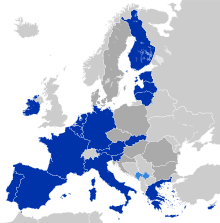Black Wednesday
Black Wednesday occurred in the United Kingdom on 16 September 1992, when the British government was forced to withdraw the pound sterling from the European Exchange Rate Mechanism (ERM) after a failed attempt to keep the pound above the lower currency exchange limit mandated by the ERM. At that time, the United Kingdom held the Presidency of the European Communities.
| Part of a series of articles on the | ||||||||||||||||||||
| British membership of the European Communities (1973–1993) and Union (1993–2020) | ||||||||||||||||||||
|---|---|---|---|---|---|---|---|---|---|---|---|---|---|---|---|---|---|---|---|---|
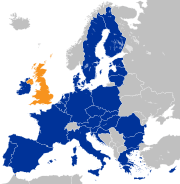 | ||||||||||||||||||||
|
Accession to the EC
|
||||||||||||||||||||
|
1975 referendum
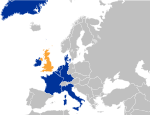 |
||||||||||||||||||||
|
Treaty amendments
Related:
|
||||||||||||||||||||
|
MEPs for UK constituencies
Women |
||||||||||||||||||||
|
Officials and bodies
|
||||||||||||||||||||
|
Issues and events
|
||||||||||||||||||||
|
||||||||||||||||||||
|
| ||||||||||||||||||||
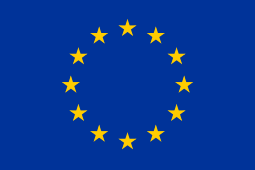 |
|---|
| This article is part of a series on the politics and government of the European Union |
|
Member States (27) Candidate countries for EU Accession
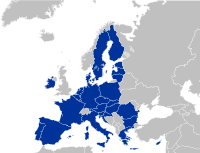 European Union since 31 January 2020 |
Treaties of Accession
Treaties of Succession
Other Treaties
Abandoned treaties and agreements
|
|
Executive
|
|
Legislature
European Parliament
(Members)
National parliaments |
|
Judiciary Court of Justice of the EU
|
|
Schengen Area Member States
Schengen Area since 2015 |
|
EEA Members
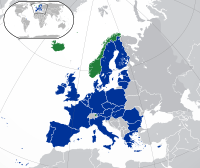 European Economic Area |
|
|
Other Bodies |
Elections in EU Member States
|
|
|
Policies and Issues
|
|
Other Other currencies in use
Non-Schengen Area States
|
|
Foreign Relations High Representative
Foreign relations of EU Member States
|
|
| ||
|---|---|---|
Prime Minister of the United Kingdom
First Ministry and Term
Second Ministry and Term
|
||
In 1997, the UK Treasury estimated the cost of Black Wednesday at £3.14 billion,[1] which was revised to £3.3 billion in 2005, following documents released under the Freedom of Information Act (earlier estimates placed losses at a much higher range of £13-27 billion).[2] Trading losses in August and September made up a minority of the losses (estimated at £800 million) and the majority of the loss to the central bank arose from non-realised profits of a potential devaluation. Treasury papers suggested that if the government had maintained $24 billion foreign currency reserves and the pound had fallen by the same amount, the UK could have made a £2.4 billion profit on the pound sterling's devaluation.[3][4]
The crisis damaged the credibility of the Second Major ministry in handling of economic matters – the Conservative Party suffered a landslide defeat five years later at the 1997 United Kingdom general election and did not return to power until 2010. The rebounding of the British economy in the years after Black Wednesday led to a reassessment of the legacy of the crisis, as the Major government's adoption of an inflation targeting policy as an alternative to the ERM set the foundation for a prospering economy in the years prior to the Financial crisis of 2007–08, and the British public turned increasingly Eurosceptic.[5][6]
Prelude
When the ERM was set up in 1979, the United Kingdom declined to join. This was a controversial decision, as the Chancellor of the Exchequer, Geoffrey Howe, was staunchly pro-European. His successor, Nigel Lawson, a believer in a fixed exchange rate, admired the low inflationary record of West Germany. He attributed it to the strength of the Deutsche Mark and the management of the Bundesbank. Thus, although the UK had not joined the ERM, from early 1987 to March 1988 the Treasury followed a semi-official policy of 'shadowing' the Deutsche Mark.[7] Matters came to a head in a clash between Lawson and Prime Minister Margaret Thatcher's economic adviser Alan Walters, when Walters claimed that the Exchange Rate Mechanism was "half baked".[8]
This led to Lawson's resignation as chancellor to be replaced by Former Treasury Chief Secretary John Major who, with Douglas Hurd, the then Foreign Secretary, convinced the Cabinet to sign Britain up to the ERM in October 1990, effectively guaranteeing that the British government would follow an economic and monetary policy preventing the exchange rate between the pound and other member currencies from fluctuating by more than 6%. On 8 October 1990, Thatcher entered the pound into the ERM mechanism at DM 2.95 to the pound. Hence, if the exchange rate ever neared the bottom of its permitted range, DM 2.773 (€1.4178 at the DM/Euro conversion rate), the government would be obliged to intervene. In 1989, UK inflation was three times the rate of Germany's, had higher interest rates at 15%, and much lower labour productivity than France and Germany, which indicated the UK's different economic state in comparison to other ERM countries.[9]
From the beginning of the 1990s, high German interest rates, set by the Bundesbank to counteract inflationary effects related to excess expenditure on German reunification, caused significant stress across the whole of the ERM. The UK and Italy had additional difficulties with their double deficits, while the UK was also hurt by the rapid depreciation of the United States Dollar – a currency in which many British exports were priced – that summer. Issues of national prestige and the commitment to a doctrine that the fixing of exchange rates within the ERM was a pathway to a single European currency inhibited the adjustment of exchange rates. In the wake of the rejection of the Maastricht Treaty by the Danish electorate in a referendum in the spring of 1992, and announcement that there would be a referendum in France as well, those ERM currencies that were trading close to the bottom of their ERM bands came under pressure from foreign exchange traders.[10]
In the months leading up to Black Wednesday, George Soros had been building a huge short position in pounds sterling that would become immensely profitable if the pound fell below the lower band of the ERM. Soros recognized the unfavourable position at which the United Kingdom joined the ERM, believing the rate at which the UK was brought into the Exchange Rate Mechanism was too high, their inflation was also much too high (triple the German rate), and British interest rates were hurting their asset prices.[11] Soros made over £1 billion in profit by short selling sterling.[12]
The currency traders act
The UK government attempted to prop up the depreciating pound to avoid withdrawal from the monetary system the country had joined only two years earlier. John Major raised interest rates to 10 percent and authorised the spending of billions worth of foreign currency reserves to buy up the sterling being sold on the currency markets, but the measures failed to prevent the pound falling below its minimum level in the ERM. The Treasury took the decision to defend sterling's position, believing that to devalue would promote inflation.[13]
Soros' Quantum Fund began a massive sell-off of pounds on Tuesday 15 September 1992. The Exchange Rate Mechanism stated that the Bank of England was required to accept any offers to sell pounds. However, the Bank of England only accepted orders during the trading day. When the markets opened in London the next morning, the Bank of England began their attempt to prop up their currency as per the decision made by Norman Lamont and Robin Leigh-Pemberton, the then Chancellor of the Exchequer and Governor of the Bank of England respectively. They began accepting orders to the amount of 300 million pounds twice before 8:30 AM to little effect.[14] The Bank of England's intervention was ineffective because Soros' Quantum Fund was dumping pounds far faster. The Bank of England continued to buy and Quantum continued to sell until Lamont told Prime Minister John Major that their pound purchasing was failing to produce results.[15]
At 10:30 AM on 16 September, the British government announced a rise in the base interest rate from an already high 10 to 12 percent to tempt speculators to buy pounds. Despite this and a promise later the same day to raise base rates again to 15 percent, dealers kept selling pounds, convinced that the government would not stick with its promise. By 7:00 that evening, Lamont announced Britain would leave the ERM and rates would remain at the new level of 12 percent; however, on the next day the interest rate was back on 10 percent.[15]
It was later revealed that the decision to withdraw had been agreed at an emergency meeting during the day between Lamont, Major, Foreign Secretary Douglas Hurd, President of the Board of Trade Michael Heseltine, and Home Secretary Kenneth Clarke (the latter three all being staunch pro-Europeans as well as senior Cabinet Ministers),[16] and that the interest rate hike to 15% had only been a temporary measure to prevent a rout in the pound that afternoon.[17]
Aftermath
Other ERM countries such as Italy, whose currencies had breached their bands during the day, returned to the system with broadened bands or with adjusted central parities.[18] Even in this relaxed form, ERM-I proved vulnerable, and ten months later the rules were relaxed further to the point of imposing very little constraint on the domestic monetary policies of member states.
The effect of the low German interest rates, and high British interest rates, had arguably put Britain into recession as large numbers of businesses failed and the housing market crashed. Some commentators, following Norman Tebbit, took to referring to ERM as an "Eternal Recession Mechanism"[19] after the UK fell into recession during the early 1990s. While many people in the UK recall Black Wednesday as a national disaster that permanently affected the country's international prestige, some Conservatives claim that the forced ejection from the ERM was a "Golden Wednesday"[20] or "White Wednesday",[21] the day that paved the way for an economic revival, with the Conservatives handing Tony Blair's New Labour a much stronger economy in 1997 than had existed in 1992[21] as the new economic policy swiftly devised in the aftermath of Black Wednesday led to re-establishment of economic growth with falling unemployment and inflation.[22] Monetary policy switched to inflation targeting.[23][24]
The Conservative Party government's image had been damaged to the extent that the electorate was more inclined to support a claim of the opposition of the time – that the economic recovery ought to be credited to external factors, as opposed to government policies implemented by the Conservatives. The Conservatives had recently won the 1992 general election, and the Gallup poll for September showed a small lead of 2.5% for the Conservative Party. By the October poll, following Black Wednesday, their share of the intended vote in the poll had plunged from 43% to 29%.[25] The debacle would ultimately tarnish the Tories' reputation (leading to three consecutive defeats in following national elections, all by large margins) until the late-2000s, when under the leadership of David Cameron, the Conservatives surpassed Gordon Brown's Labour government in party image for the first time since September 1992 (partly because of the effects of the Great Recession), eventually gaining the most seats at the 2010 general election. However, the 2010 general election resulted in a hung parliament as had been predicted; with the Conservatives forming a coalition government with the Liberal Democrats led by Nick Clegg.
See also
- Impossible trinity
- Sale of UK gold reserves, 1999–2002
Footnotes
- Dury, Hélène. "Black_Wednesday" (PDF). Retrieved 24 February 2016.
- Tempest, Matthew (9 February 2005). "Treasury papers reveal cost of Black Wednesday". The Guardian. London, UK. Retrieved 26 April 2010.
- Freeman, Harold. "The Cost of Black Wednesday Reconsidered" (PDF). HM Treasury. p. 4. Archived from the original (PDF) on 3 April 2013. Retrieved 9 October 2018.
- "Guide to the papers and full list of documents". HM Treasury. Archived from the original on 3 April 2013. Retrieved 9 October 2018.
- McRae, Hamish (2005-02-10). How the ERM disaster turned into a triumph. The Independent. Retrieved 2019-10-21.
- Moore, Charles (2018-11-03). Bring on the next Black Wednesday. The Spectator. Retrieved 2019-10-21.
- "Not while I'm alive, he ain't – Part 4 Thatcher and Lawson". The Westminster Hour. BBC Radio 4. 15 May 2003.
- Sir Alan Walters. The Daily Telegraph (2009-01-05). Retrieved 2019-10-21.
- [https://libcom.org/library/britain-european-exchange-rate-mechanism 1990-1992: Britain and the politics of the European exchange rate mechanism]. Libcom (2006-01-13). Retrieved 2019-10-21.
- Aykens, Peter. Conflicting Authorities: States, Currency Markets and the ERM Crisis of 1992-93. Review of International Studies, Vol. 28, No. 2 (Apr., 2002), pp. 359-380. Retrieved 2019-10-21.
- Sebastian Mallaby (10 June 2010). More Money Than God: Hedge Funds and the Making of a New Elite. Penguin Press HC. ISBN 9781594202551.
- Litterick, David (13 September 2002). "Billionaire who broke the Bank of England". The Daily Telegraph. London, UK. Retrieved 24 February 2013.
- Bootle, Roger (28 April 2008). "Pound fall is UK's get-out-of-jail-free card". The Daily Telegraph. London, UK.
- Litterick, David (13 September 2002). "Billionaire who broke the Bank of England". Telegraph. Retrieved 16 May 2014.
- Inman, Phillip (2012-09-13). Black Wednesday 20 years on: how the day unfolded . The Guardian. Retrieved 2019-10-21.
- Major's dither cost UK billions, says Lamont. The Independent (1999-09-27). Retrieved 2019-10-21.
- Johnston, Philip (2012-09-10). Black Wednesday: The day that Britain went over the edge. The Daily Telegraph. Retrieved 2019-10-21.
- Sevilla, Christina R. Explaining the September 1992 ERM Crisis: The Maastricht Bargain and Domestic Politics in Germany, France, and Britain. Harvard University. Retrieved 2019-10-21.
- Tebbit, Norman (10 February 2005). "An electoral curse yet to be lifted". The Guardian. London, UK. Retrieved 30 December 2008.
- "A strong-arm policy is needed to hold the pound down on the rebound". Roger Bootle. London, UK: The Telegraph. 15 May 2009.
- Kaletsky, Anatole (9 June 2005). "The reason that Europe is having a breakdown...it's the Euro, stupid". The Times. UK. Retrieved 30 December 2008.(subscription required)
- Archived 16 October 2011 at the Wayback Machine
- "Inflation Targeting Has Been A Successful Monetary Policy Strategy". NBER. Retrieved 31 October 2016.
- "Targeting Inflation: The United Kingdom in Retrospect" (PDF). IMF. Retrieved 31 October 2016.
- "Gallup spreadsheet". Archived from the original on 13 October 2009. Retrieved 28 July 2014.
External links
- Black Wednesday, bbc.co.uk; accessed 11 January 2017.
- Black Wednesday is remembered as a dark day in British economic history. But the clouds were lined with gold. Martin Upton, head of the Centre for Financial Management at The Open University Business School tells Ione Mako about the upside, open.edu, 24 September 2009.
